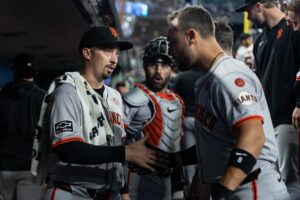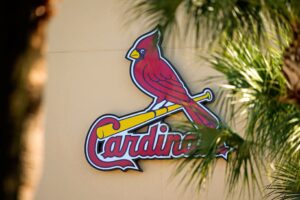While it may not seem like much, the Miami Marlins have gone through what very few teams during a regular season have ever had. That was gaining national attention without even having played an inning for several days.
A COVID-19 outbreak within the team forced the Marlins to stay grounded in Philadelphia after taking on the Phillies on Opening Day weekend. From the first day all the way until recently, the number count was rising. That in turn gave question as to whether the Marlins would continue their season. It has forced Derek Jeter, Michael Hill, and other top brass to make some quick personnel changes. That has included placing Garrett Cooper, Jose Urena, and Harold Ramirez on the 10-day injured list.
That’s on top of the seven different relief pitchers after a total of 18 players had tested positive for COVID-19. Along with that, Miami’s starting second baseman Isan Diaz, opted out of the 2020 season. The 24-year old cited health and family concerns on Instagram.
They Need a Statcast Offense
Following the green light to resume their season, Miami must find a way to overcome the temporary loss of 18 players and pick back where they left off. A good way to do that would be to improve upon statcast metrics. Metrics which have ushered in a new wave of cutting edge offense and awe-inspiring power. With metrics like barrels, exit velocity, and launch angle, teams like the Minnesota Twins have been able to power past the competition.
Recently, offensive dominance hasn’t been synonymous with the Miami Marlins. Over the last two years, Miami has resided in the bottom three of the league in home runs, extra-base hits, and total runs scored. It has been primarily a singles team where strikeouts and groundballs have dominated the conversation. They haven’t helped themselves out either in the walks department. The Miami Marlins have resided in the bottom seven each of the last two seasons in free passes.
Improving the statcast metrics should be able to put a spark in what otherwise has been a near lifeless offense the last few seasons. Last year alone, the Marlins were last in launch angle (8.8 degrees). Subsequently, the Marlins were driven to a league-worst ground-ball rate of 49.5 percent. That’s with the league average launch angle at 12.7 degrees and a ground ball rate at 43.8 percent. Individually, according to baseballsavant.com, only four Marlins batters achieved a launch angle of ten degrees or more with a minimum of 200 batted ball events. Depending on how you view it, the fact that Brian Anderson (with a launch angle of 10.9 degrees) is the only one of those four still left on Miami’s roster.
More Urgency
One indication as to the lack of power across last year’s Marlins team was their lack of barrels met. That’s based on a minimum exit velocity of 98 miles per hour with a 26-30 degree launch angle. For Miami, they were dead last in that department (241) and only three players achieved a barrel rate of 30 or more. That includes Brian Anderson (31), Jorge Alfaro (32), and Starlin Castro (33). All three were far cries from Jorge Soler’s 70 barrels met.
If all that wasn’t enough, perhaps a bigger need to rely on statcast metrics would be due to the number of contracts that will be arbitration-eligible. According to Cot’s Baseball Contracts, Miami has eight contracts currently on the books that will be arbitration-eligible for the first time this offseason. Overall, the Marlins will wield 12 players with arbitration-eligible contracts to address this offseason. Five of those will be position players. The more recent arbitration-eligible individuals are Alfaro, Lewis Brinson, Anderson, and Garrett Cooper.
A Newly Acquired Strength
The Miami Marlins may have sported a lack-luster offense as of late, but the future looks different. Alongside the lead of manager Don Mattingly, the Marlins will also feed off of the experience of James Rowson. Rowson comes to Miami after a successful turnaround of the Minnesota Twins offense. Under his tutelage, the Twins turned around their offensive ways and led MLB teams in launch angle (14.9 degrees). With that, the Twins pushed to a new single-season home run record with 307 long balls. That helped Minnesota to top the MLB ranks in expected batting average, slugging percentage, and on-base percentage in 2019.
While the Marlins have been slow offensively the last few years, there have been a few bright spots. Miami was in the top 10 in connecting on pitches in the strike zone (82.9 percent). That came despite sporting the second-highest chase rate (32.5 percent)
The Marlins seem to have the right approach in place to springboard their improvement but only time will tell. With a minor league foundation and a different approach by top brass, the Marlins have a solid start that just might surprise a lot of people in 2020. Their restart back into competition comes tonight in Baltimore followed by a doubleheader battle (also in Baltimore) on Wednesday.
Main Image
Embed from Getty Images






